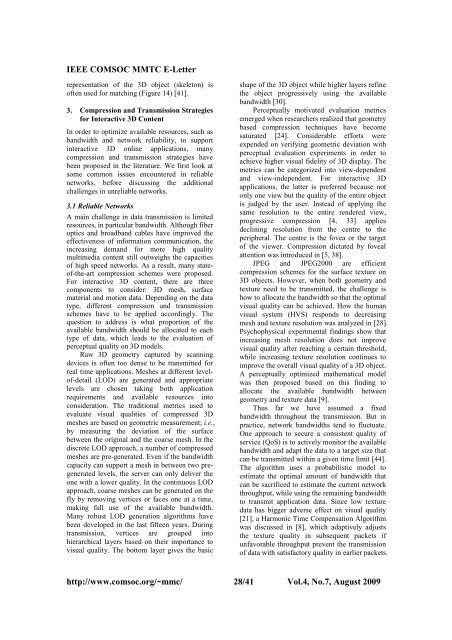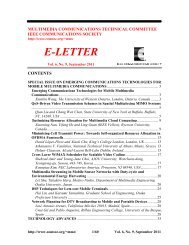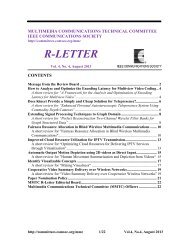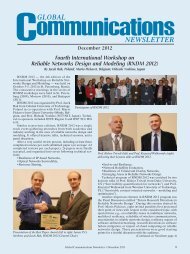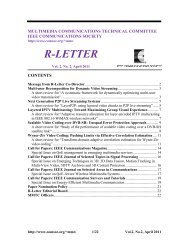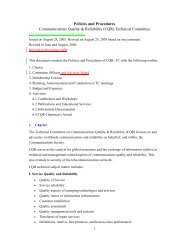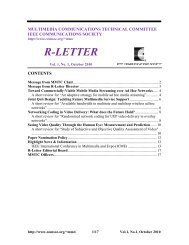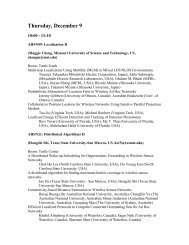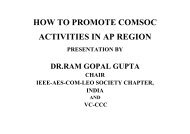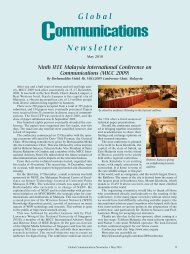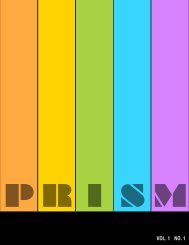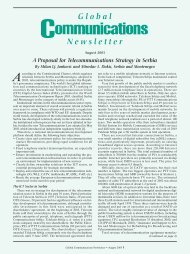E-LETTER - IEEE Communications Society
E-LETTER - IEEE Communications Society
E-LETTER - IEEE Communications Society
Create successful ePaper yourself
Turn your PDF publications into a flip-book with our unique Google optimized e-Paper software.
<strong>IEEE</strong> COMSOC MMTC E-Letterrepresentation of the 3D object (skeleton) isoften used for matching (Figure 14) [41].3. Compression and Transmission Strategiesfor Interactive 3D ContentIn order to optimize available resources, such asbandwidth and network reliability, to supportinteractive 3D online applications, manycompression and transmission strategies havebeen proposed in the literature. We first look atsome common issues encountered in reliablenetworks, before discussing the additionalchallenges in unreliable networks.3.1 Reliable NetworksA main challenge in data transmission is limitedresources, in particular bandwidth. Although fiberoptics and broadband cables have improved theeffectiveness of information communication, theincreasing demand for more high qualitymultimedia content still outweighs the capacitiesof high speed networks. As a result, many stateof-the-artcompression schemes were proposed.For interactive 3D content, there are threecomponents to consider: 3D mesh, surfacematerial and motion data. Depending on the datatype, different compression and transmissionschemes have to be applied accordingly. Thequestion to address is what proportion of theavailable bandwidth should be allocated to eachtype of data, which leads to the evaluation ofperceptual quality on 3D models.Raw 3D geometry captured by scanningdevices is often too dense to be transmitted forreal time applications. Meshes at different levelof-detail(LOD) are generated and appropriatelevels are chosen taking both applicationrequirements and available resources intoconsideration. The traditional metrics used toevaluate visual qualities of compressed 3Dmeshes are based on geometric measurement; i.e.,by measuring the deviation of the surfacebetween the original and the coarse mesh. In thediscrete LOD approach, a number of compressedmeshes are pre-generated. Even if the bandwidthcapacity can support a mesh in between two pregeneratedlevels, the server can only deliver theone with a lower quality. In the continuous LODapproach, coarse meshes can be generated on thefly by removing vertices or faces one at a time,making full use of the available bandwidth.Many robust LOD generation algorithms havebeen developed in the last fifteen years. Duringtransmission, vertices are grouped intohierarchical layers based on their importance tovisual quality. The bottom layer gives the basicshape of the 3D object while higher layers refinethe object progressively using the availablebandwidth [30].Perceptually motivated evaluation metricsemerged when researchers realized that geometrybased compression techniques have becomesaturated [24]. Considerable efforts wereexpended on verifying geometric deviation withperceptual evaluation experiments in order toachieve higher visual fidelity of 3D display. Themetrics can be categorized into view-dependentand view-independent. For interactive 3Dapplications, the latter is preferred because notonly one view but the quality of the entire objectis judged by the user. Instead of applying thesame resolution to the entire rendered view,progressive compression [4, 33] appliesdeclining resolution from the centre to theperipheral. The centre is the fovea or the targetof the viewer. Compression dictated by fovealattention was introduced in [5, 38].JPEG and JPEG2000 are efficientcompression schemes for the surface texture on3D objects. However, when both geometry andtexture need to be transmitted, the challenge ishow to allocate the bandwidth so that the optimalvisual quality can be achieved. How the humanvisual system (HVS) responds to decreasingmesh and texture resolution was analyzed in [28].Psychophysical experimental findings show thatincreasing mesh resolution does not improvevisual quality after reaching a certain threshold,while increasing texture resolution continues toimprove the overall visual quality of a 3D object.A perceptually optimized mathematical modelwas then proposed based on this finding toallocate the available bandwidth betweengeometry and texture data [9].Thus far we have assumed a fixedbandwidth throughout the transmission. But inpractice, network bandwidths tend to fluctuate.One approach to secure a consistent quality ofservice (QoS) is to actively monitor the availablebandwidth and adapt the data to a target size thatcan be transmitted within a given time limit [44].The algorithm uses a probabilistic model toestimate the optimal amount of bandwidth thatcan be sacrificed to estimate the current networkthroughput, while using the remaining bandwidthto transmit application data. Since low texturedata has bigger adverse effect on visual quality[21], a Harmonic Time Compensation Algorithmwas discussed in [8], which adaptively adjuststhe texture quality in subsequent packets ifunfavorable throughput prevent the transmissionof data with satisfactory quality in earlier packets.http://www.comsoc.org/~mmc/ 28/41 Vol.4, No.7, August 2009


